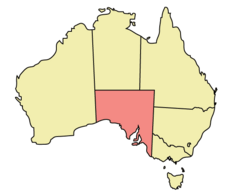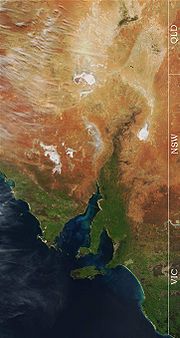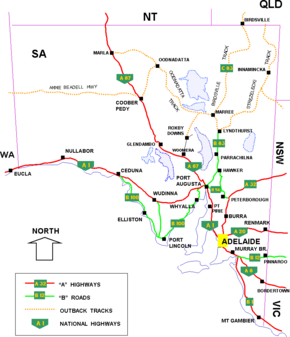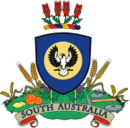South Australia
| South Australia | |||||
|
|||||
| Slogan or Nickname: Festival State | |||||
 Other Australian states and territories |
|||||
| Capital | Adelaide | ||||
|---|---|---|---|---|---|
| Government | Constitutional monarchy | ||||
| Governor | Kevin Scarce | ||||
| Premier | Mike Rann (ALP) | ||||
| Federal representation | |||||
| - House seats | 11 | ||||
| - Senate seats | 12 | ||||
| Gross State Product (2006-07) | |||||
| - Product ($m) | $65,676[1] (5th) | ||||
| - Product per capita | $41,820 (7th) | ||||
| Population (September 2008) | |||||
| - Population | 1,598,000 (5th) | ||||
| - Density | 1.61/km² (6th) 4.2 /sq mi |
||||
| Area | |||||
| - Total | 1,043,514 km² (4th) 402,903 sq mi |
||||
| - Land | 983,482 km² 379,725 sq mi |
||||
| - Water | 60,032 km² (5.75%) 23,178 sq mi |
||||
| Elevation | |||||
| - Highest | Mt. Woodroffe 1,435 m (4,708 ft) |
||||
| - Lowest | Lake Eyre -16 m (-52 ft) |
||||
| Time zone | UTC+9:30 (+10:30 DST) | ||||
| Abbreviations | |||||
| - Postal | SA | ||||
| - ISO 3166-2 | AU-SA | ||||
| Emblems | |||||
| - Faunal | Hairy-Nosed Wombat Lasiorhinus latifrons) |
||||
| - Bird | Piping Shrike | ||||
| - Floral | Sturt's Desert Pea (Swainsona Formosa) |
||||
| - Aquatic | Leafy Seadragon (Phycodurus eques) |
||||
| - Gem | Opal | ||||
| - Colour | Red, Blue, Gold | ||||
| Web site | www.sa.gov.au | ||||
South Australia is a state of Australia in the southern central part of the country. It covers some of the most arid parts of the continent; with a total land area of 983,482 square kilometres (379,725 sq mi), it is the fourth largest of Australia's six states and two territories.
It is bordered to the west by Western Australia, to the north by the Northern Territory and Queensland, to the east by Queensland, New South Wales and Victoria, and along the south by the Great Australian Bight and the Southern Ocean.[2] With nearly 1.6 million people, the state comprises less than 10% of the Australian population and ranks fifth in population among the states and territories.
The majority of its people reside in the state capital, Adelaide, with most of the remainder settled in fertile areas along the south-eastern coast and River Murray.
The state's origins were unique in Australia as a freely-settled, planned British province rather than a convict settlement. Official settlement began on 28 December 1836, when the state was proclaimed at The Old Gum Tree by Governor John Hindmarsh.
The first city/town to be established was Kingscote, Kangaroo Island, established in 1836. The guiding principle behind settlement was that of systematic colonisation, a theory espoused by Edward Gibbon Wakefield that was later employed by the New Zealand Company.
The aim was to establish the province as a centre of civilisation for free immigrants, promising civil liberties and religious tolerance. Although its history is marked by economic hardship, South Australia has remained politically innovative and culturally vibrant. Today, the state is known as a state of festivals and of fine wine.
The state's economy centres on the agricultural, manufacturing and mining industries and has an increasingly significant finance sector as well.
Contents |
History
The first recorded European sighting of the South Australian coast was in 1627 when the Dutch ship the Gulden Zeepaert, skippered by Francois Thijssen, examined the coastline. Thijssen named his discovery "Pieter Nuyts Land", after the highest ranking individual on board.
The coastline of South Australia was first mapped by Matthew Flinders and Nicolas Baudin in 1802. Baudin referred to the land as "Terre Napoléon".
In 1834, the British Parliament passed the South Australia Act 1834, which enabled the province of South Australia to be established. The act stated that 802,511 square kilometres (309,851 sq mi) would be allotted to the colony and it would be convict-free. The plan for the colony was that it would be the ideal embodiment of the best qualities of British society, that is, no religious discrimination or unemployment.
Settlement of nine vessels and 636 people was temporarily made at Kingscote on Kangaroo Island, until the official site of the colony was selected where Adelaide is currently located. The first immigrants arrived at Holdfast Bay (near the present day Glenelg) in November 1836, and the colony was proclaimed on 28 December 1836, now known as Proclamation Day. South Australia is the only Australian state to be settled entirely by free settlers.
The current flag of South Australia was adopted on 13 January 1904, and is a British blue ensign defaced with the state badge. The badge is described as a Piping Shrike with wings outstretched on a yellow disc. The state badge is believed to have been designed by Robert Craig of the Adelaide School of Arts.
South Australia granted restricted women's suffrage in 1861, and in 1894 became the second place in the world to grant universal suffrage (after New Zealand) where women had the dual rights to vote and to stand for election.[3]
Geography

The terrain consists largely of arid and semi-arid rangelands, with several low mountain ranges in which the most important mountains are the Mt Lofty-Flinders Ranges system which extends north about 800 kilometres (497 mi) from Cape Jervis to the northern end of Lake Torrens and salt lakes.
The highest point in the state is not in those ranges, but Mount Woodroffe at 1,435 metres (4,708 ft) in the Musgrave Ranges in the extreme northwest of the state.[4] The western portion of the state consists of the sparsely-inhabited Nullarbor Plain fronting the cliffs of the Great Australian Bight.
The principal industries and exports of South Australia are wheat, wine and wool. More than half of Australia's wines are produced there.
South Australia has boundaries with every other Australian state and territory except the Australian Capital Territory and Tasmania. The area now known as the Northern Territory was annexed to South Australia in 1863, however it was handed over to the federal government in 1911 and became a separate territory. South Australia's south coast is flanked by the Southern Ocean.
Climate
Its mean temperature range is 29 °C (84 °F) in January and 15 °C (59 °F) in July. Daily temperatures in parts of the state in January and February can be up to 48 °C (118 °F).
The highest maximum temperature was recorded as 50.7 °C (123.3 °F) at Oodnadatta on 2 January 1960, which is the highest official temperature recorded in Australia. The lowest minimum temperature was −8 °C (17.6 °F) at Yongala on 20 July 1976[5]
Economy
The manufacturing industry plays a very important role in South Australia's economy, generating 15% of the state's Gross State Product (GSP) and playing a large part in exports. The manufacturing industry consists of automotive (44% of total Australian production, 2006) and component manufacturing, pharmaceuticals, defence technology (2.1% of GSP, 2002-2003) and electronic systems (3.0% of GSP in 2006). South Australia's economy relies on exports more than any other state in Australia. Export earnings stand at AUD$10 billion worth per year and grew by 8.8% from 2002 to 2003.
Production of South Australian food and drink (including agriculture, horticulture, aquaculture, fisheries and manufacturing) is a $10 billion industry.
South Australia's economic growth has lagged behind the rest of Australia for some time (2.1% from 2002 to 2003), but performance seems to be improving. South Australia's credit rating was upgraded to AAA+, having lost it in the State Bank collapse. South Australia's Gross State Product was AUD$48.9 billion starting 2004, making it AUD$32,996 per capita. Exports for 2006 were valued at $9.0bn with imports at $6.2bn. Private Residential Building Approvals experienced 80% growth over the year of 2006.
South Australia's economy includes the following major industries: meat and meat preparations, wheat, wine, wool and sheepskins, machinery,metal and metal manufactures, fish and crustaceans, road vehicles and parts, and petroleum products. Other industries, such as education and defence technology, are of growing importance.
South Australia receives the least amount of federal funding for its local road network than any other state on a per capita or per kilometre basis.[6]
Olympic Dam
South Australia possesses the world's single largest known deposit of uranium, at the Olympic Dam mine. Olympic Dam contains 40% of the world's known uranium reserves. The Olympic Dam mine is also the world's fourth largest remaining copper deposit, and the world's fifth largest gold deposit.
Government
South Australia is a constitutional monarchy with the Queen of Australia as Sovereign, and the Governor of South Australia as her representative.[7] It is a state of the Commonwealth of Australia. Its bicameral parliament consists of a House of Assembly (lower house) and a Legislative Council (upper house), with legislative elections held every four years. The current Premier of South Australia is Mike Rann, a member of the Australian Labor Party.
Initially, the Governor of South Australia held almost total power, derived from the Letters Patent of the Imperial Government to create the colony. He was only accountable to the British Colonial Office, and thus democracy did not exist in the colony. A new body was created to advise the governor on the administration of South Australia in 1843 called the Legislative Council.[8] It consisted of three representatives of the British Government and four colonists appointed by the governor. The governor retained total executive power.
In 1851, the Imperial Parliament enacted the Australian Colonies Government Act which allowed for the election of representatives to each of the colonial legislatures and the drafting of a Constitution to properly create representative and responsible Government in South Australia. Later that year, wealthy male colonists were allowed to vote for 16 members on a new 24 seat Legislative Council. Eight members continued to be appointed by the governor.
The main responsibility of this body was to draft a Constitution for South Australia. The body drafted the most democratic constitution ever seen in the British Empire and provided for manhood suffrage. It created the bicameral Parliament of South Australia. For the first time in the colony, the executive was elected by the people and the colony used the Westminster system, where the government is the party or coalition that exerts a majority in the House of Assembly. In 1894, South Australia was the first Australian colony to allow women to vote and it had the first Parliament in the world to allow women to be elected as members. Catherine Helen Spence was the first woman in Australia to be a candidate for political office when she nominated to be one of South Australia's delegates to the constitutional conventions that drafted the Constitution. South Australia became an original state of the Commonwealth of Australia on 1 January 1901.
Demographics
Population
A majority of the states population live within Adelaide's metropolitan area which had an estimated population of 1,158,259 in 2007 (70.3% of the state). Other significant population centres include Mount Gambier (approx. 23,494), Whyalla (21,122), Murray Bridge (18,364), Port Augusta (13,257), Port Pirie (13,206), Port Lincoln (13,044), and Victor Harbor (10,380).[9]
Education

- See also: List of schools in South Australia
Education is compulsory for all children until age 16, however, the majority of students stay on to complete their South Australian Certificate of Education (SACE). School education is the responsibility of the South Australian government, but the public and private education systems are funded jointly by it and the Commonwealth Government.
The South Australian Government provides, to schools on a per student basis, 89 percent of the total Government funding while the Commonwealth contributes 11 percent. Since the early 1970s it has been an ongoing controversy[10] that 68 percent of Commonwealth funding (increasing to 75% by 2008) goes to private schools that are attended by 32% of the states students.[11]
From 1 January 2009, the school leaving age will be raised to 17.[12]
There are three universities in South Australia: University of Adelaide, Flinders University and University of South Australia . All are based in Adelaide, and Mount Gambier.[13] Carnegie Mellon University's Heinz School and "Entertainment Technology Center" have campuses in Adelaide.[14]
Tertiary vocational education is provided by TAFE South Australia colleges throughout the state.
Sport
Australian rules football is the most popular sport in South Australia. [1] The state has the highest participation rate of people taking part in Australian Football, with over 2.2% of the population aged 18 years and over participating in the sport.[15] South Australia fields two teams, the Adelaide Crows and Port Adelaide Power in the Australian Football League national competition.
The Adelaide Crows have a membership base of 50,000,[16] higher than any of the other 15 teams in the competition. Both teams regularly draw large crowds. The South Australian National Football League, which owns the dedicated Australian Football stadium AAMI Stadium, is a popular local league comprising nine teams.
South Australia's soccer team in the new A-League is Adelaide United. Basketball also has a big following in South Australia with the Adelaide 36ers playing out an 8,070 seat stadium in Findon and winning four championships in the last 20 years in the National Basketball League (Australia). South Australia also has a cricket team, the Southern Redbacks, who play at Adelaide Oval in North Adelaide during the summer; however they have not won a title since 1996. The Redbacks currently have four players who hold a contract with Cricket Australia.
Fifty-nine percent of children take part in organised sports. For boys, soccer has the highest participation rate (22%) followed by swimming (16%). For girls netball is most popular (18%) followed by swimming (16%).[17]
Notable places

|
Regions:
Rivers:
|
Lakes:
Islands:
|
Main highways:
|
See also
- Adelaide
- Towns in South Australia
- Cities in South Australia
- Local Government Areas of South Australia
- List of highways in South Australia
- List of cities and towns in South Australia
- List of people from Adelaide
- Proclamation Day: 28 December 1836
- SA Country Fire Service
- South Australian Ambulance Service
- Pie floater
- South Australian food and drink
- Adelaide Festival of Arts
- South Australian wine
References
- ↑ Australian National Accounts: State Accounts, 2006-07
- ↑ Most Australians describe the body of water south of the continent as the Southern Ocean, rather than the Indian Ocean as officially defined by the International Hydrographic Organization (IHO). In 2000, a vote of IHO member nations defined the term "Southern Ocean" as applying only to the waters between Antarctica and 60 degrees south latitude.
- ↑ Women and Politics in South Australia The State Library of South Australia
- ↑ "Highest Mountains". Geoscience Australia. Retrieved on 2006-05-28.
- ↑ "World temperature extremes" (2005-10-17). Retrieved on 2006-05-28.
- ↑ "Inquiry into Local Government and Cost Shifting". Australian House of Representatives (2003). Retrieved on 2007-06-11.
- ↑ "R v Governor of South Australia [1907 HCA 31; (1907) 4 CLR 1497 (8 August 1907)]". Australasian Legal Information Institut (2008). Retrieved on 2008-07-19.
- ↑ "Legislative Council 1843-1856". Parliament of South Australia (2005). Retrieved on 2006-05-28.
- ↑ "Estimated Resident Population, SA". ABS (31 March 2008). Retrieved on 2008-09-16.
- ↑ The Redefinition of Public Education
- ↑ Ministerial Council National Report on Schooling in Australia
- ↑ Owen, Michael (2006-05-22). "School leaving age to be raised", The Advertiser, News Corp. Retrieved on 2006-05-28.
- ↑ "Campuses and maps". University of South Australia (2006-03-15). Retrieved on 2006-05-28.
- ↑ "Welcome to ETC: Australia". Carnegie Mellon University. Retrieved on 2006-05-28.
- ↑ source AuSport 2000
- ↑ Adelaide Crows (2006-05-23). "50,000 milestone coming closer". Press release. Retrieved on 2006-05-28.
- ↑ Australian Bureau of Statistics Children's Participation in Cultural and Leisure Activities PDF Doc
- Dorothy Jauncey, Bardi Grubs and Frog Cakes — South Australian Words, Oxford University Press (2004) ISBN 0-19-551770-9
External links
- South Australia Central
- Official Insignia And Emblems Page
- South Australian Tourism Commission - Travel Guides, Accommodation, Tours, Online Booking, Maps etc
- South Australia's Climate Change Strategy (2007)
- The Encyclopædia of South Australian Culture Locals reflect on South Australian culture.
- Ground Truth - towards an Environmental History of South Australia Community resources
|
|||||||||||
|
||||||||||||||||
|
||||||||||

